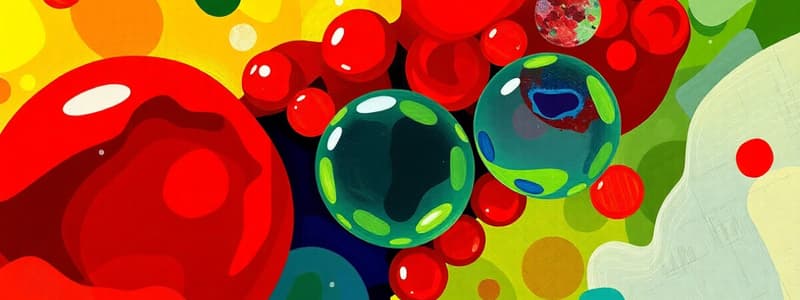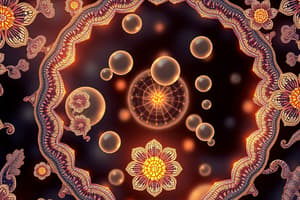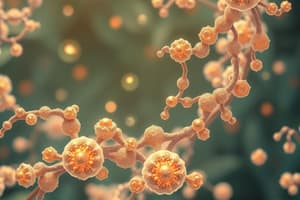Podcast
Questions and Answers
What is the primary storage form of fats in animals and humans?
What is the primary storage form of fats in animals and humans?
- Cholesterol
- Phospholipids
- Triacylglycerols (TAGs) (correct)
- Fatty acids
Which term describes fats that are solid at room temperature?
Which term describes fats that are solid at room temperature?
- Monounsaturated fats
- Polyunsaturated fats
- Trans fats
- Saturated fats (correct)
What is a key characteristic of unsaturated fatty acids?
What is a key characteristic of unsaturated fatty acids?
- They have high melting points.
- They remain solid at room temperature.
- They have nonlinear chains that do not pack closely. (correct)
- They have linear chains that pack closely.
Which type of fatty acid typically has thick liquids or soft solids at room temperature?
Which type of fatty acid typically has thick liquids or soft solids at room temperature?
What is the advised maximum percentage of total kilocalories for saturated fat consumption due to health risks?
What is the advised maximum percentage of total kilocalories for saturated fat consumption due to health risks?
Which statement about polyunsaturated fatty acids is true?
Which statement about polyunsaturated fatty acids is true?
Which fatty acid is referenced by its common name, stearic acid?
Which fatty acid is referenced by its common name, stearic acid?
Which type of fat has low melting points and is typically liquid at room temperature?
Which type of fat has low melting points and is typically liquid at room temperature?
What type of enzymes are responsible for the hydrolysis of triglycerides in the body?
What type of enzymes are responsible for the hydrolysis of triglycerides in the body?
Which phosphoglyceride has a net charge of 0 at pH 7?
Which phosphoglyceride has a net charge of 0 at pH 7?
Which of the following phosphoglycerides has the most negative net charge at pH 7?
Which of the following phosphoglycerides has the most negative net charge at pH 7?
What is the net charge of cardiolipin at pH 7?
What is the net charge of cardiolipin at pH 7?
Which of the following is NOT a component of phosphatidylcholine?
Which of the following is NOT a component of phosphatidylcholine?
What is the primary function of triglycerides in the body?
What is the primary function of triglycerides in the body?
Which type of lipid is known for being amphipathic?
Which type of lipid is known for being amphipathic?
Which lipids are primarily responsible for the absorption of fat-soluble vitamins?
Which lipids are primarily responsible for the absorption of fat-soluble vitamins?
What characteristic of lipids contributes to their ability to act as a thermal blanket?
What characteristic of lipids contributes to their ability to act as a thermal blanket?
What is a key function of cholesterol in biological membranes?
What is a key function of cholesterol in biological membranes?
Which group of lipids primarily serves as metabolic regulators?
Which group of lipids primarily serves as metabolic regulators?
Which best describes the solubility of lipids in water?
Which best describes the solubility of lipids in water?
Among the following, which lipids are noted for providing cushioning effects for internal organs?
Among the following, which lipids are noted for providing cushioning effects for internal organs?
What is the primary difference between facilitated transport and active transport?
What is the primary difference between facilitated transport and active transport?
Which type of transport is facilitated by specific carrier proteins and does not require energy?
Which type of transport is facilitated by specific carrier proteins and does not require energy?
What process is directly linked to the hydrolysis of ATP?
What process is directly linked to the hydrolysis of ATP?
Which of the following is an example of secondary active transport?
Which of the following is an example of secondary active transport?
Cotransport mechanisms such as antiport and symport are characterized by what feature?
Cotransport mechanisms such as antiport and symport are characterized by what feature?
What is the function of cholesterol in the lipid bilayer?
What is the function of cholesterol in the lipid bilayer?
Which of the following statements regarding biological membranes is true?
Which of the following statements regarding biological membranes is true?
What does the partition coefficient measure?
What does the partition coefficient measure?
Which factor increases the permeability of a substance in the lipid bilayer?
Which factor increases the permeability of a substance in the lipid bilayer?
Which chemical property favors diffusion through the membrane?
Which chemical property favors diffusion through the membrane?
What differentiates passive diffusion from other transport processes?
What differentiates passive diffusion from other transport processes?
Which type of transport system involves the movement of molecules in opposite directions?
Which type of transport system involves the movement of molecules in opposite directions?
What role do polar groups play in chemical transport across membranes?
What role do polar groups play in chemical transport across membranes?
Which of the following phospholipids is found in the inner layer of the RBC membrane?
Which of the following phospholipids is found in the inner layer of the RBC membrane?
What is the main characteristic of molecules that penetrate cell membranes easily?
What is the main characteristic of molecules that penetrate cell membranes easily?
What is the main function of lipoproteins in the body?
What is the main function of lipoproteins in the body?
Which lipoprotein is considered 'bad' cholesterol?
Which lipoprotein is considered 'bad' cholesterol?
Which class of lipids primarily composes biological membranes?
Which class of lipids primarily composes biological membranes?
What role do the protein components of lipoproteins play?
What role do the protein components of lipoproteins play?
What is the typical LDL/HDL ratio for a healthy person?
What is the typical LDL/HDL ratio for a healthy person?
What is a characteristic feature of the lipid bilayer structure?
What is a characteristic feature of the lipid bilayer structure?
Which of the following is a common phosphoglyceride found in membranes?
Which of the following is a common phosphoglyceride found in membranes?
What is a major function of glycolipids in membranes?
What is a major function of glycolipids in membranes?
Which type of protein interacts extensively with the hydrocarbon region of the bilayer?
Which type of protein interacts extensively with the hydrocarbon region of the bilayer?
What is one important characteristic of the nonpolar hydrocarbon tail in lipid bilayers?
What is one important characteristic of the nonpolar hydrocarbon tail in lipid bilayers?
Flashcards
Lipids
Lipids
Water-insoluble compounds that dissolve in nonpolar organic solvents.
Triglycerides
Triglycerides
The storage form of energy among lipids.
Phospholipids and Cholesterol
Phospholipids and Cholesterol
Structural components of biological membranes.
Steroid Hormones and Prostaglandins
Steroid Hormones and Prostaglandins
Signup and view all the flashcards
Amphipathic Lipids
Amphipathic Lipids
Signup and view all the flashcards
Amphipathic function
Amphipathic function
Signup and view all the flashcards
Lipid function in body
Lipid function in body
Signup and view all the flashcards
Diverse lipid structure
Diverse lipid structure
Signup and view all the flashcards
Triglyceride hydrolysis
Triglyceride hydrolysis
Signup and view all the flashcards
Phosphoglyceride
Phosphoglyceride
Signup and view all the flashcards
Phosphatidylcholine
Phosphatidylcholine
Signup and view all the flashcards
Phosphatidylserine
Phosphatidylserine
Signup and view all the flashcards
Triacylglycerols (TAGs)
Triacylglycerols (TAGs)
Signup and view all the flashcards
Saturated fatty acids
Saturated fatty acids
Signup and view all the flashcards
Unsaturated fatty acids
Unsaturated fatty acids
Signup and view all the flashcards
Monounsaturated fatty acids (MUFA)
Monounsaturated fatty acids (MUFA)
Signup and view all the flashcards
Polyunsaturated fatty acids (PUFA)
Polyunsaturated fatty acids (PUFA)
Signup and view all the flashcards
Fatty acid structure
Fatty acid structure
Signup and view all the flashcards
Lipid storage in humans
Lipid storage in humans
Signup and view all the flashcards
Recommended daily intake of saturated fats
Recommended daily intake of saturated fats
Signup and view all the flashcards
What is cotransport?
What is cotransport?
Signup and view all the flashcards
What is facilitated transport?
What is facilitated transport?
Signup and view all the flashcards
What is active transport?
What is active transport?
Signup and view all the flashcards
What is primary active transport?
What is primary active transport?
Signup and view all the flashcards
What is secondary active transport?
What is secondary active transport?
Signup and view all the flashcards
Lipoprotein
Lipoprotein
Signup and view all the flashcards
LDL
LDL
Signup and view all the flashcards
HDL
HDL
Signup and view all the flashcards
Lipid Bilayer
Lipid Bilayer
Signup and view all the flashcards
Phospholipids
Phospholipids
Signup and view all the flashcards
Glycolipids
Glycolipids
Signup and view all the flashcards
Integral Membrane Protein
Integral Membrane Protein
Signup and view all the flashcards
Peripheral Membrane Protein
Peripheral Membrane Protein
Signup and view all the flashcards
Membrane Fluidity
Membrane Fluidity
Signup and view all the flashcards
Cholesterol's Role in Membranes
Cholesterol's Role in Membranes
Signup and view all the flashcards
Membrane Asymmetry
Membrane Asymmetry
Signup and view all the flashcards
Passive Diffusion
Passive Diffusion
Signup and view all the flashcards
Partition Coefficient
Partition Coefficient
Signup and view all the flashcards
Why Ionized Substances Have Trouble Crossing Membranes
Why Ionized Substances Have Trouble Crossing Membranes
Signup and view all the flashcards
Factors Affecting Membrane Permeability
Factors Affecting Membrane Permeability
Signup and view all the flashcards
Uniport, Antiport, and Symport
Uniport, Antiport, and Symport
Signup and view all the flashcards
What Makes Diffusion Easier?
What Makes Diffusion Easier?
Signup and view all the flashcards
Study Notes
Lipids: Overview
- Lipids are a diverse group of biomolecules, insoluble in water, soluble in nonpolar solvents.
- The term "lipid" comes from the Greek word "lipos," meaning fat
- They are not polymers of a specific monomer, unlike proteins or DNA, due to their diverse structures.
- They serve as energy storage, structural components of biomembranes and act as surfactants, detergents, and emulsifying agents. They also provide insulation and cushion internal organs, and help in absorbing fat-soluble vitamins.
Lipid Functions
- Triglycerides: Store energy.
- Phospholipids and cholesterol: Form structural components of biomembranes.
- Steroid hormones and prostaglandins: Act as metabolic regulators.
- Amphipathic lipids: Act as surfactants, detergents, and emulsifying agents, acting as insulators in neurons.
- Lipids provide insulation against temperature changes.
- Lipids protect internal organs.
- Lipids help with the absorption of fat-soluble vitamins A, D, E, and K.
- Lipids enhance the taste and palatability of food.
Classification of Lipids: Storage
- Triacylglycerols (TAGs) / Triglycerides: Esters of glycerol and fatty acids; major storage form of fats in animals and humans.
- Structure: Composed of a glycerol molecule and three fatty acid chains.
- Saturated fatty acids: Molecules closely packed, high melting points, solid form at room temperature.
- Unsaturated fatty acids: Nonlinear chains, do not pack closely, low melting points, liquid form at room temperature.
Classification of Lipids: Unsaturated Fatty Acids
- Polyunsaturated fatty acids (PUFAs): Essential fatty acids (mammals cannot synthesize them).
- Examples: Linoleic acid (omega-6) and linolenic acid (omega-3) - important for physiological functions.
- Arachidonic acid is derived from linoleic acid and is a precursor for many prostaglandins.
Classification of Lipids: Omega fatty acids
- Omega-6 fatty acid: Linoleic acid.
- Omega-3 fatty acid: Linolenic acid, eicosapentaenoic acid (EPA), and docosahexaenoic acid (DHA) - critical for many physiological processes.
Classification of Lipids: Waxes
- Esters of long-chain fatty acids and high molecular weight monohydric alcohols.
- Examples: Beeswax, lanolin.
Classification of Lipids: Membrane Lipids
- Phospholipids: Glycerols, fatty acids, phosphate, and a polar head group; are components of biological membranes.
- Examples of phosphoglycerides: Phosphatidic acid, phosphatidylethanolamine, phosphatidylcholine, phosphatidylserine, and phosphatidylglycerol.
- Sphingolipids: Sphingosine, fatty acids, phosphate, and a polar head group; important components of membranes.
- Examples of sphingolipids: Ceramide, sphingomyelin, glycosphingolipids (e.g., cerebrosides, gangliosides), and sphingolipids with complex oligosaccharides
Classification of Lipids: Nonsaponifiable Lipids
- Terpenes: Polymers of isoprene unit, e.g., fat-soluble vitamins A, D, E, and K.
- Steroids: Characterized by a tetracyclic carbon skeleton. Includes cholesterol, bile acids, steroid hormones (e.g., cortisol, testosterone, estrogen), and Vitamin D.
- Steroid alcohols: Includes cholesterol and other sterols.
Lipids in Membranes
- Fluid Mosaic Model: Membranes are a dynamic structure consisting of phospholipids and proteins.
- Membrane asymmetry: The asymmetrical distribution of phospholipids and glycolipids in the bilayer of human RBCs is noted.
- Movement in the membrane: includes diffusion (lateral and transbilayer) and rotation.
- Cholesterol is a key regulator of fluidity: Important in maintaining membrane fluidity and preventing extremes in fluidity.
Transport Across Membranes
- Chemical Transport: Describes the movement of substances across cell membranes, encompassing passive diffusion, active transport (primary and secondary), and facilitated transport.
- Different factors such as size, charge, and lipid solubility influence how effectively a substance crosses the membrane.
- Carrier-Mediated Transport: Uses protein transporters to move substances across.
- Active Transport: Uses energy against the concentration gradient, moving substances from low to high concentration.
Lipoproteins
- Lipoproteins transport cholesterol and triacylglycerols in the blood.
- LDL ("bad cholesterol"): transports cholesterol to peripheral tissues.
- HDL ("good cholesterol"): picks up cholesterol from dying cells, delivering it to the liver for excretion.
Studying That Suits You
Use AI to generate personalized quizzes and flashcards to suit your learning preferences.




